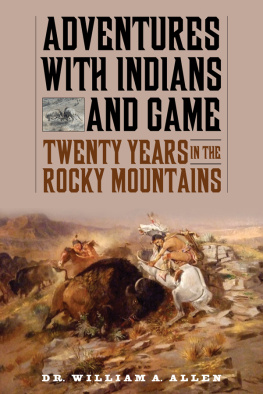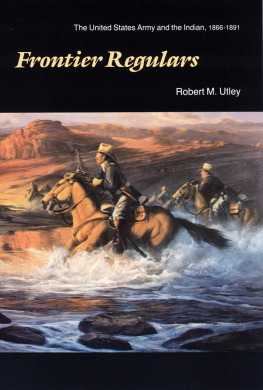

DEDICATION.

W ITH acknowledgments to L IEUTENANT -G ENERAL S HERMAN , whose suggestions at Fort Kearney, in the spring of 1866, were adopted, in preserving a daily record of the events of a peculiarly eventful journey, and whose vigorous policy is as promising of the final settlement of Indian troubles and the quick completion of the Union Pacific Railroad as his March to the Sea was signal in crushing the last hope of armed rebellion, this narrative is respectfully dedicated.
MARGARET IRVIN CARRINGTON.
First published in 1868
First Skyhorse Publishing edition 2015
All rights reserved. No part of this book may be reproduced in any manner without the express written consent of the publisher, except in the case of brief excerpts in critical reviews or articles. All inquiries should be addressed to Skyhorse Publishing, 307 West 36th Street, 11th Floor, New York, NY 10018.
Skyhorse Publishing books may be purchased in bulk at special discounts for sales promotion, corporate gifts, fund-raising, or educational purposes. Special editions can also be created to specifications. For details, contact the Special Sales Department, Skyhorse Publishing, 307 West 36th Street, 11th Floor, New York, NY 10018 or info@skyhorsepublishing.com.
www.skyhorsepublishing.com
10 9 8 7 6 5 4 3 2 1
Library of Congress Cataloging-in-Publication Data is available on file
Cover design by Anthony Morais
Cover painting Attack by Crow Indians by Alfred Jacob Miller
Print ISBN: 978-1-62914-712-3
Ebook ISBN: 978-1-62914-850-2
Printed in the United States of America
ILLUSTRATIONS.

CONTENTS.

Absaraka, Home of the Crows
Absaraka described
The Natural History and Climate of Absaraka
Organization of the Expedition to Absaraka
From Fort Kearney to crossing of Union Pacific RailroadIncidents of the Platte River TravelReunion of the Officers of the 18th InfantryCrossing the Ridiculous Platte
Reminiscences of Ranching, and old times on the route from Leavenworth to Sedgwick
Union Pacific Railroad to LaramieCourt-house RockChimney RockFortification RockScotts BluffsWonderful FishingVisit of Standing Elk
Fort Laramie Council of 1866Its results foreshadowedThe Aborigines in the marts of tradeHow the Indians did and did not
Laramie to RenoCamp Phisterer CaonLaramie PeakWild FloraPumpkin Buttes
Fort RenoIndian RaidFort Laramie Treaty testedFourth of July in AbsarakaOrganization of Mountain DistrictOnward MovementMore RattlesnakesMercury 113 above zeroWhat it did
ReconnoissancesIndian messengersWarningsLocation of Fort Philip KearneyConduct of the troops, and its cause
Arrival of IndiansThe Cheyennes in councilBlack Horse, The Rabbit that Jumps, Red Sleeve, Dull Knife, and others have much talk and heap of smoke
Massacre of Louis Gazzous partyIndian raid and great loss of mulesThe Cheyennes againForty hostile demonstrations of the peaceable tribesThe Laramie Treaty incidentally testedMassacre of Lieutenant DanielsA fighting parson
Conduct of the Crow IndiansWhat Bridger and Beckwith say
Visit of Inspector-General HazenReinforcements on the wayMounted Infantry compared with Sioux Light CavalryUnited States mailsCorral systemTimber and lumber supplied to order
Fort Philip Kearney and surroundingsA picnicAscent of the mountainsLake SmedtFine sceneryPlan of the fort
Two holidaysOctober inspection and reviewFirst garrison flag hoisted in AbsarakaIncidents of the dayIndian response to a national saluteLooking-glasses in abundanceEvening levee
A day of incidentsHostile Sioux and friendly CheyennesNarrow escape of the latterOur picket mimickedMore massacresCroquet introduced into Absaraka
Night scenesCelestial and terrestrial visitorsAuroraLunar rainbowMeteoritesIndians all in their war-paint
Domestic, social, and religious life, with the episodes therein occurring
Indian warfareThings a woman can learn when she has seen them tried
Indian arms, habits, and customsThe arrow beats the revolver
Massacre of Lieutenant BinghamAccounts given by officersExtracts from journal
Fettermans massacreIts lessons
The funeralBurial of fourscore and one victims of the massacreCold and sad holidaysExpeditions abandonedReinforcements of August yet behind
Comedy of errorsEnterprise of the pressTransactions in Absaraka mysteriously known to the public before they had information of the same
New Years changes1867March to Fort RenoMercury 40 below zeroHow it felt and what it did
Fort Reno to Fort CasparThence to the United StatesCourtesies of the routeVisits of dignitaries, military, civil, and Indian, at McPhersonMore changes
In memoriam
Omaha to Virginia City, Montana
PROLOGUE.

T HE importunity of friends, who have been interested in the journal of a summers trip and a winters experience on the Plains, and which, as a matter of taste, now assumes the more easy flow of Narrative, has overruled the first refusal to permit its use in more available form for their leisurely reading. Gathering many of its details from officers of the posts, from Major James Bridger, and others, and so gathering as each days experience unfolded events of interest, there is no assumption of anything further than to express the facts so recorded just as they were impressed upon the judgment or fancy.
If, on the one hand, the recital of military preparations or movements be so inartificial as to excite the smile of the critic, or if the natural tendency to adopt the idioms and style which, every way and forever, surround the wife of an officer, shall seem so constrained as to repel the lady reader, it can only be said that we wrote, when we wrote, just as the surroundings inspired or compelled us.
In this change from the form of a journal we have adhered to its record, and preserved the integrity of the original, so as to reproduce our life as it was lived and give incidents as they transpired.
While nearly one-half of the Indian demonstrations were under our own eye, the authentic reports of others were of equal value to history; and the narrative differs little from what would be the written experience of others, except that we availed ourselves more fully of classes of facts and sources of knowledge equally open to all, and so cherished their record, as in earlier life we garnered up details of a first visit to Mammoth Cave or the Falls of Niagara.
If our statistics and statements as to Indian councils, usages, or raids, or the record of labor, casualties, and incidents, savor much of routine , yet through incidental form we have gathered historical facts, and thus do we present our life and the exact history of the first year of the military occupation of Absaraka.
And again; if there be a savor of whining because the soldiers were so few and support was unfurnished, it will not be taken as criticism to offend anybody, since everybody knows how small was the army, and how incapable of immediate expansion to meet the issues of the Northwestern frontier at the close of the war.
Next page








